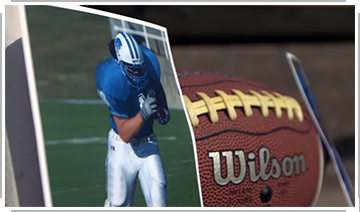The Problem
Concussion = Internal Collision
 Brady Beran playing football in high school
Courtesy NET Foundation and Tom & Carol Beran |
This internal collision is hard enough on an adult brain. It seems to be even harder on the developing brain. New research shows that young athletes are especially vulnerable to the effects of concussion.
|
Brady Beran’s Story
|
Since 1945, over 510 brain injury fatalities have occurred in football (Mueller, 2010). The highest incidence was recorded between 1965 and 1974, when 162 were reported. But fatalities have declined sharply since then due to implementation of rules to prevent spearing and other causative mechanisms. In 2013, the Nebraska Department of Health and Human Services surveyed youth from the Nebraska Brain and Spinal Cord Injury Registry about concussions in sports, revealing some of their behaviors and beliefs regarding concussions. These youth had received medical treatment for and were identified as having concussions. |

|
2013 Nebraska Sports Concussion Youth Survey Results
